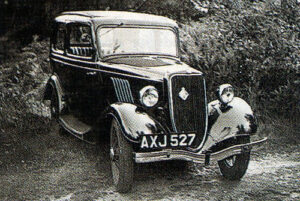
When the Second World War ended in 1945 the economic situation was gloomy, and austerity remained the keynote.
The first post-war cars were merely modifications of pre-war designs. Later, with emphasis on export and particularly the dollar, car styles copied the American look with horizontal grilles instead of a traditional vertical radiators, giving cars appearances which in my view ranged from the tasteless to the downright ugly.
British export-only models persisted into the early 1950s, although it was hardly surprising that a few always managed to stay at home – at a price!
For most people wages were low and money short. The solution was a covenant scheme under which anyone taking delivery of a new car had to sign an undertaking to keep it for at least a year – later extended to two years.
Rationed petrol – a miserable 74 octane ‘Pool’ – was available at two shillings a gallon, enough for perhaps 200 miles a month, and business users had to fight for the extra provided by their ‘E’ (essential purposes) coupon.
Gone were the days of the £100 car. In 1945 the cheapest was the Ford Anglia, whose asking price of £293 included £64 purchase tax. I drove an Anglia in 1947 when I hired one for a holiday.
It was the early 1950s before motoring became reestablished. Petrol rationing ceased, although the tax was doubled at the same time. The giant Esso refinery at Fawley was officially opened in 1951, and vast new steel sheet rolling mills in South Wales were commissioned, which meant an end to shortages and a continuing rise in production.
In the summer of 1951 I visited the Festival of Britain exhibition on the South Bank. The transport pavilion covered rail, road, sea and air. Commercial vehicles and motorcycles dominated the road section. There were only four cars exhibited and a notice said that these were changed frequently “to give a fair display to all the variety of makes.”
There were additional sections on car design and achievements in motor racing and record breaking. Also on display was the first turbine-engined car – a Rover, aptly registered JET 1.
The proposed motorway scheme was shown, which included a model of the new Severn Bridge. Little did I realise that a decade later, when I lived at Bristol, I’d be watching the entire construction of this bridge.
Second-hand pre-war cars were still around. I bought a Ford Model Y in 1951 for £150. This had been the first truly Dagenham-designed model – Fords were at Trafford Park, Manchester until 1931. Introduced in 1932, the Model Y cost £100 in 1935, and more than 220,000 had been sold up to 1939.
The braking was very poor – I had several close shaves until I allowed for it. It was a question of changing down and using the engine as a brake as much as possible.
On one horrific occasion I was driving along a quiet country road (luckily for me) when there was a bump and suddenly the steering wheel was spinning round in my hands – not connected to anything! The car veered to the left and mounted the verge before I could stop. Fate was kind that day – there was nothing coming the other way and nothing behind me.
In 1953 branded petrols returned with a rise in octane to 94 for premium grades.
Most of us had small cars then. My neighbour ran a pre-war Morris Eight; others included a Standard Eight and an Austin A30 – just as well, for Nasser nationalised the Suez Canal and petrol rationing returned from December 1956 until May 1957.
A year later I was driving a second-hand 1,265cc Hillman Minx. It ran well enough, but I wasn’t impressed.
Roads were improving, but very slowly. The Preston by-pass – the first road to the motorway standard – was opened in 1958 and the first section of M1 in November 1959.
By the end of the decade there were some ten million vehicles on British roads – and an awful lot more still to come.
Dennis Strange








